The Apple Thunderbolt Display Review
by Anand Lal Shimpi on September 23, 2011 2:56 AM EST- Posted in
- Displays
- Mac
- Apple
- Thunderbolt
- Thunderbolt Display
Ever since I moved to a notebook as my main work computer I've become increasingly annoyed with the process of actually moving my notebook-as-a-desktop around. At my desk I've got DisplayPort, Ethernet, two USB, FireWire 800, speakers and power all plugged into a 15-inch MacBook Pro. What makes it frustrating isn't the first-world-problem of having to unplug seven cables, rather that it doesn't need to be seven cables - Apple could make the whole thing happen with just two.
Every Mac released in 2011 has at least one Thunderbolt port (the iMac has two), and Thunderbolt can deliver exactly what I'm looking for. Thunderbolt can carry two things: PCI Express and DisplayPort, the former for data and the latter obviously for video. Why would you want to carry PCIe and DP over a single cable? To address problems like the one above.
Pretty much all device expansion on modern day PCs happens via PCI Express. Several years ago it was hard to find PCIe sound cards or Ethernet controllers, but these days vanilla PCI slots are nearing extinction and PCIe is the de facto standard. Ethernet, USB and FireWire controllers all exist as single-lane PCIe devices. Put a bunch of them at the other end of a Thunderbolt cable and you no longer need to plug in a bunch of individual cables into your notebook when at your desk. Send DisplayPort over the same cable and you can actually move all of those ports onto your monitor, thereby using a single cable to carry everything but power to your display. And this is exactly what Apple has done with its new Thunderbolt Display. By mating its 27-inch LED Cinema Display with a bunch of integrated IO controllers, Apple is hoping to deliver a display that's more of a mobile docking station than just a passive way to display video.
Apple has tried this in the past. The old Cinema Displays used to feature an Apple Display Connector (ADC) that actually carried DVI, USB and power from a desktop Mac to the monitor. You only needed to plug in a single cable to your display, significantly reducing desktop clutter. Although Thunderbolt does carry power, it's limited to 10W - not enough to power any reasonably sized display. Where Thunderbolt does win out over ADC however is in its universal appeal. Intel created the standard. Although it's used almost exclusively on Apple systems today, come 2012 Intel is expecting PC OEMs to embrace the interface with its Cactus Ridge line of Thunderbolt controllers.

Apple's Thunderbolt Display
The Thunderbolt Display uses a near, if not perfectly, identical panel to what was in last year's 27-inch LED Cinema Display. You get a 27-inch, 16:9, 2560 x 1440 LED backlit display capable of at least 350 nits at full brightness. Apple seems to conservatively spec its desktop displays as we were able to measure 425 nits at max brightness. The uber brightness comes in handy because the display does have a glossy finish. Indoors it's not really a problem unless you're watching a dark movie scene with the display lit by a sun-facing window. Even then, cranking up the brightness all the way is usually enough to overcome any significant glare. As with all glossy displays, if you have light control (e.g. curtains or blinds) you'll be just fine.
The similarities don't end with the internal panel, the chassis is very similar to its older sibling and the Thunderbolt Display retails for the same $999 price.
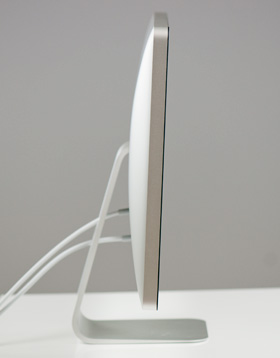 |
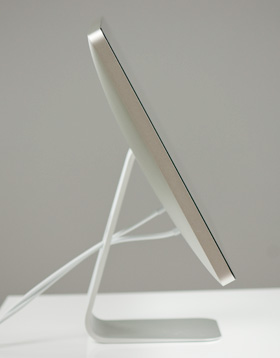 |
The display sits on an aluminum swivel base that allows for -5 degrees to 25 degrees of tilt along the horizontal axis. There's no height adjustment for the display either, only tilt. Personally, I use a height adjustable desk as I find it helps me avoid any carpal tunnel pain. Combined with a height adjustable chair, the lack of height adjustment on the display doesn't bother me. If you have a fixed height desk however, this may be a problem.
Aesthetically the Thunderbolt Display continues Apple's aluminum meets glass design language. The front of the display is all glass, while the edges and back are all aluminum. Along the top surface of the display is a mic for the integrated FaceTime HD camera. The outgoing 27-inch LED Cinema Display (still available for purchase online) sported a 640 x 480 camera, while the Thunderbolt Display ups capture resolution to 1280 x 720.
There's an ambient light sensor hidden in the top bezel of the display, but as always you can disable its functionality from within OS X.

There are two integrated speakers in the display, again unchanged from the previous LED Cinema Display.
Two cables attach directly to the display: a removable power cable and an integrated IO cable. Cable management is done through a round cutout in the aluminum stand. The IO cable is where things really change with the Thunderbolt Display. Instead of a breakout of three cables as was the case with the Cinema Display, there are now only two: MagSafe and Thunderbolt.
The MagSafe connector remains unchanged. If you've got any Mac that can be charged by an 85W MagSafe adapter, the Thunderbolt Display will charge said Mac. This feature alone is particularly awesome for notebook-as-a-desktop users since it allows you to just keep your actual AC adapter tucked away in your travel bag. For me I keep my MagSafe adapter in my bag and never take it out so I never have to worry about forgetting to pack it. Given how expensive MagSafe adapters are ($79 for an 85W), this is a nice feature for MacBook Air/Pro owners.
The Thunderbolt cable is obviously what gives this new display its name. Inside the Thunderbolt Display is an Intel Light Ridge Thunderbolt controller. The type of controller is important as it bestows upon the display some clear limitations. The biggest of course is the lack of support for all non-Thunderbolt systems. That's right, the only way to get video to the Thunderbolt Display is by using a Thunderbolt enabled Mac (or theoretically a Thunderbolt enabled PC). For Mac users that means only 2011 MacBook Pro, Air, iMac or Mac mini models will work with the Thunderbolt Display. Everyone else has to either buy a new Mac or stick with older displays.
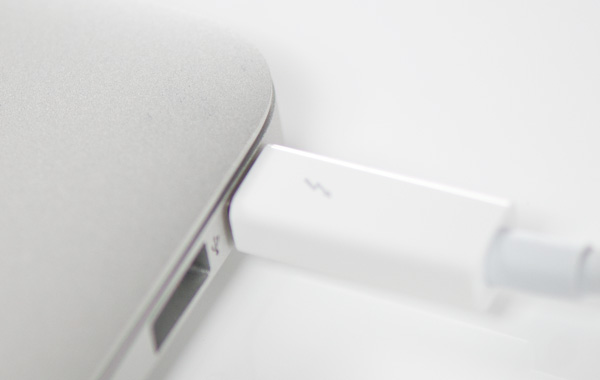
I believe the limitation here is actually on the cable side. A Thunderbolt cable can only transmit a Thunderbolt signal. Although DisplayPort is muxed in, if the display on the other end is expecting Thunderbolt and it receives DisplayPort it won't know what to do with it. It's possible Apple could have built in logic to autosense and switch between Thunderbolt and DisplayPort as inputs, but Apple traditionally employs clean breaks rather than long technology transitions. If Apple wants to ensure Thunderbolt gets adopted (at least by its users), this is the way to do it. As we learned from other legacy interfaces (e.g. PS/2, IDE), if you enable backwards compatibility you'll ensure the survival of systems that implement those interfaces. It's not so great for existing customers unfortunately.


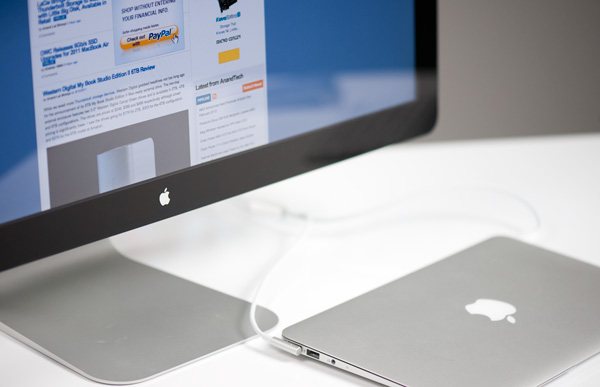
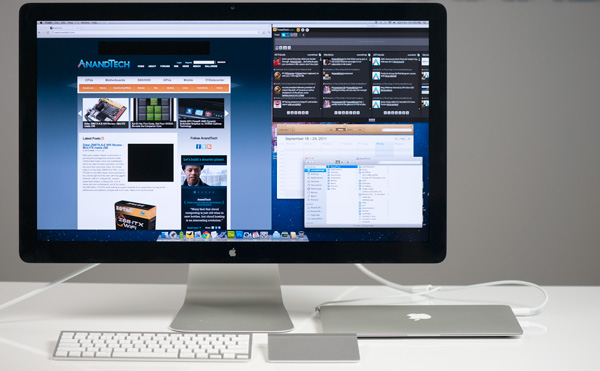
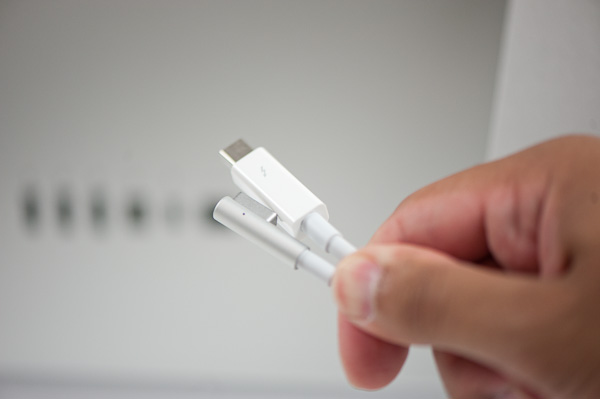








275 Comments
View All Comments
GotThumbs - Friday, September 23, 2011 - link
It's a hardware review and the specs are in the article. This is not intended to be an MTV production to keep ADD kids entertained. Either you find the content interesting or now. If not, change the channel.Iketh - Friday, September 23, 2011 - link
OSDs would have only distracted me... i was listening to him like we were having a 1 on 1... overlays would have fucked that upxodius80 - Friday, September 23, 2011 - link
i must say is not only entertaining to see the video but its so much easier to understand, notes on what ive seen u might need:Fisrt a green screen so u can put your logo anywhere so you dont compromise your publicity on depending hardware reviews, your persona blocked your logo, and thats not good for bussiness, all the time it was reading nandtech, def not good =), a little more post production if u got the time, even tho it was perfect , heres an idea, like the time u where explaining the motherboard inside the monitor, it should have disolved to the picture into a main whole frame, while your voice in off, then disolve back to you. things like that make videos more intresting.
sorry for my english, just helping you out since ive studied video here in my country, nice job man! ohh yeah and cool mic haha.
fynamo - Friday, September 23, 2011 - link
Just for everyone's reference, these displays do work with Windows. I've been using one for a while and love it. The only issue I had was when trying to adjust the brightness. You have to do some weird tweaks with AppleControlPanel.exe but I was eventually able to make it work.KLC - Friday, September 23, 2011 - link
Interesting hardware information, but why doesn't anyone talk about the stupid name? What's a thunderbolt? I know lightning bolts and I know thunder claps. Who made up this name Google Translator?jecs - Friday, September 23, 2011 - link
The technology is from Intel and I am not sure if the name itself is Intel or an Apple idea based on the Intel name. This is the first implementation and has a lot more potential but depends on how it will be adopted by the industry.Dug - Friday, September 23, 2011 - link
I really enjoyed it too. This gives a far more personal touch to the review and the visuals give a clear example of what you are talking about.I've always liked seeing things in action because stagnant pictures don't tell the whole story.
SickBeast - Friday, September 23, 2011 - link
How much does the thing cost?This website needs to stop functioning as marketing PR and should get back to its roots as a hardware review website. The price of this display should be boldly listed both in the introduction and the conclusion of the article.
The review of Windows Vista on this website really opened my eyes to the fact that AnandTech has gone in a completely new direction. It's too bad.
Anand, please revert to your role as a journalist and stop acting as a puppet for these large corporations.
jecs - Friday, September 23, 2011 - link
$1000 formally $999But tell me what product, a decent one deserving a good review, does not comes with a brand name and marketing?
Your whole observation is very emotional.
Anand, please keep with the good work! not because I ask for it.
mharding - Friday, September 23, 2011 - link
The Thunderbolt Display's motherboard is full of controllers driving all of the rear facing IO ports. On the front we actually see the very first non-SFF Eagle Ridge IC. Although the MacBook Air uses Eagle Ridge, it uses the SFF version in a cheaper package. I'm sure what determines whether or not Apple uses the flip-chip packaged version.Thanks for the review - I much prefer reading quickly than watching a video slowly.